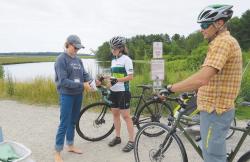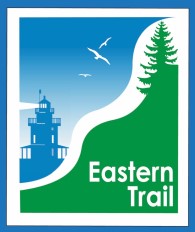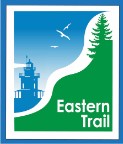
By Michael Kelley, Staff Writer | Scarborough Leader Online | July 21, 2017
Three environmentally-focused groups are coming together to connect with strollers, bicyclists and runners on the Eastern Trail to gauge what the trail, and the Scarborough Marsh, which the trail cuts through in Scarborough, means to them and educate passersby about the value of the marsh.
This summer, through funding from Friends of Scarborough Marsh and support from the Eastern Trail Alliance, interns from Maine Audubon have staffed an information table along the Eastern Trail Fridays, Saturdays and Sundays.
Friends of Scarborough Marsh Vice President Steve Pinette, who came up with the idea, said the aim of the table is to teach trail users about the “flora, fauna and history of the marsh and the trail.”
Rowan Price, one of the Scarborough March Audubon Center interns staffing the table, said the response has been good. Many users pass by, but others stop by the table to chat, pick up a map of the trail/marsh or look at the display case or hides.
“If they don’t about (the trail) already, they become interested in it after they have walked on it,” said Price, a resident of Portland who is heading into her senior year at Dickinson College in Carlisle, Pennsylvania.
Most of the questions she fields are about the Eastern Trail, but Price, and the other interns, do field questions about the marsh and its ecosystem.
Pinette said the Scarborough Marsh Audubon Center, run by Audubon educator and Friends of Scarborough Marsh board member Linda Woodard, does a “great job” educating people, especially children, about the marsh. Pinette said he was looking for a way to reach people who may not stop by the nature center.
I thought another way to get people would be on the Eastern Trail,” he said.
Better educating the public about the marsh and its ecosystem, is a big part of what Pinette, a retired geologist is trying to do as a member of the Friends group.
“I want to make sure we are fulfilling our mission of educating the citizens of Scarborough and the adjacent area about nature and the environment as it applies to the marsh,” Pinette said. “It is a vital natural resources for many things – for recreation, vital habitat, flood control. It’s a bellwether for global climate change.”
As part of the educational effort, the Friends of Scarborough Marsh will be creating a 12-question quiz to handout to people on the trail and through their website.
At Scarborough’s SummerFest on Friday, Aug. 18, the group will raffle off prizes, including a birding tour of the marsh, binoculars and birding and natural resources books, to those who answered the questions right.
The marsh, according to the Maine Audubon website, has had a long history of use. The Sokokis Indians used the area for hunting, trapping, clamming and fishing. By the 1600s European settlers began using the marsh for harvesting hay for cattle and sheep. When haying began to decline in the 1900s, the marsh was seen as a place to fill for developments and was even proposed as the site of the town dump.
Read the entire article online here
<!– the rest of the article in case the online version goes away
In 1957, Maine Department of Inland Fisheries and Wildlife began a 20-year of trying to preserve the marsh. In 1972 Maine Audubon and the state teamed up to convert an old clam shack on the property into a nature center, which every year attracts more than 10,000 people. Friends of Scarborough Marsh was founded in 2000.
While the Maine Audubon interns work to educate the public about the marsh and the Eastern Trail and compile number as to how many people are using the trail, Carole Brush, the executive director of the Eastern Trail Alliance, said that group is in the midst of conducting a study to see what sort of economic impact the users of the Eastern Trail have on the area.
The effort, led by Eastern Trail Alliance Trustee Jim Bucar picks up on an economic impact study Eastern Trail founder John Andrews, who died in February, did in 2014. Andrews’ study found that Eastern Trail users contributed more than $857,500 to the local economy in 2014 from purchases made at area shops, restaurant and lodging establishments.
“We are looking to relaunch that study on the trail and online to collect data from our users – who they are, what they are looking for – in order to gain momentum to complete the trail,” Brush said.
The corridor the Eastern Trail utilizes in most of Scarborough – the old Eastern Railroad line – dates to 1841 when it housed the Portland, Saco and Portsmouth Rail line.
The Eastern Railroad Company bought the rail line in 1872 and operated it until 1945. Portland Gas and Electricity purchased the line in 1965 to use for a natural gas line, which is operated by Unitil today.
Since it opened in 2004, the Scarborough section of Eastern Trail has been used by countless walkers, bikers, runners and for a number of regular events, such as full moon hikes – scheduled to next take place in Scarborough Monday, Aug. 9 at 8 p.m. and Wednesday, Sept. 6 at 7 p.m., Thursday, October 5 at 6 p.m. and Saturday, Nov. 4 at 6 p.m. and Sunday, Dec. 3 at 4 p.m. and the Loop and Lunch Rides, set for Saturday, Aug. 19, Saturday, Sept. 30 and Saturday, Oct. 21.
The Eastern Trail Alliance’s biggest fundraiser of the year, the Annual Maine Lighthouse bike ride is scheduled to take place Saturday, Sept. 9. The event offers bicyclists the opportunity to ride 25 to 100 miles and pass up to nine area lighthouses from Goat Island Light in Cape Porpoise to Portland Breakwater Light at Bug Light Park in South Portland.
Brush is interesting in hearing from trail users, whether they take part in events on the trail or use it for private passive recreation.
“I encourage people to share their stories on the trail. These stories are helpful for us to secure funding to complete the trail. It is great to hear from our users,” Brush said, referencing Close the Gap, a large fundraising effort underway to fund a $3.8 million project to extend the Eastern Trail 1.6 miles from the Nonesuch River in Scarborough to the Wainwright Sports Complex in South Portland.
The project includes building two bridges, one over the river and one over the Pam Am Railways line used by the Amtrak Downeaster. So far, thanks to private donors, money from Scarborough and South Portland, Maine Department of Transportation, Portland Area Comprehensive Transportation System and area businesses, only roughly $500,000 has to be raised. Closing this gap will create 16 miles of off-road trail from Bug Light in South Portland to downtown Saco.
Aside from the connection from Scarborough to South Portland, Brush said the Eastern Trail Alliance is also working on closing a 19-mile gap from Kennebunk to South Berwick.
–!>












0 comments
Write a comment